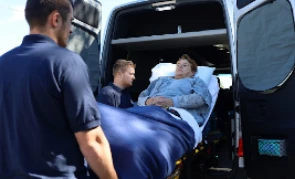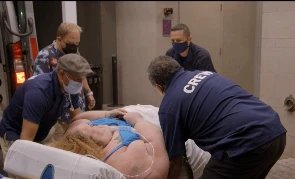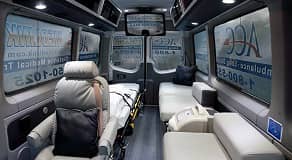Many people struggle to find a suitable non-emergency medical transportation (NEMT) service that will allow them travel interstate for medical visits. It is tempting to go on a road trip with a loved one on the wheels when you have a medical appointment in another state.
However, issues may arise that neither of you can handle properly. Therefore, investing in a state-to-state medical transportation service appears to be the ideal option when making interstate medical trips. Here are four important reasons why you should patronize this service:
Nothing beats the joy of knowing you or your loved ones are safe, especially when traveling with state-to-state medical transportation services. NEMT firms provide training for their employees on managing medical emergencies. They also install GPS trackers on the vehicles to keep tabs on the progress of the medical trips.
Hence, loved ones can be sure that the clients have reached their destination in time and without issues. Consequently, they will have peace of mind, which boosts the family’s well-being.
Patronizing a state-to-state medical transportation service helps clients avoid no-shows for their medical appointments. During medical trips, drivers are tasked with monitoring the client’s medical status on a round-the-clock basis.
In addition, the vehicle is equipped with vital medical devices to prevent complications that may develop due to a medical condition. Similarly, research shows that diabetic patients in need of wound care can attend a monthly average of 5.5 treatment sessions when NEMT service is patronized as opposed to a monthly average of 1.3 treatments when NEMT service is unavailable.
Also, patients can now visit hospitals far away from home for various medical procedures due to state-to-state medical transportation services. This translates to improved health outcomes.
Top NEMT firms offering interstate medical transportation services ensure their employees have industry-level training on patient care while in transit to medical facilities. The drivers are skilled at mental health transport and managing traumatic brain injuries. They also have a broad knowledge of hospitals and clinics in different states.
In addition, they are trained to monitor the medical condition and provide basic medical assistance when necessary. NEMT vehicles are equipped with installations that allow for the safe transport of non-ambulatory patients, especially those using wheelchairs. All in all, top NEMT firms are dedicated to the highest level of care and prioritize safety and comfort.
NEMT services make state-to-state medical transportation more bearable and less stressful for clients. Employees usually assist clients from the residence into the NEMT vehicles. They also ensure that clients get into the medical facility safely.
Furthermore, clients can book rides from the comfort of their homes. They can also customize NEMT services to meet their needs. However, interstate medical trips are boring and uncomfortable due to the long hours on the road. NEMT ensures that clients find the vehicle convenient and relaxing.
Taking advantage of the services of a state-to-state medical transportation service is beneficial for those who want optimized medical care and supervision while in transit across various state lines. NEMT services not only guarantee peace of mind but also ensure that they receive excellent care, have better health outcomes, and are more comfortable without having to break the bank.
Medicaid and Medicare beneficiaries are lucky to have several medical procedures and services covered by these healthcare schemes. Unfortunately, they still have several obstacles that hinder their access to medical care.
A significant example of these hindrances is the lack of transportation. According to a national survey in the United States, an estimated 3.6 million people delay or do not show up for their medical appointment due to inadequate transport options.
NEMT or Non-emergency Medical Transportation helps make transportation accessible to people who have no other means of getting to their medical appointments, especially those who are disabled or elderly. Besides, some have chronic diseases like cancer, obstructive pulmonary disease, diabetes, and kidney diseases.
In addition, clients with these medical conditions need to visit their healthcare providers for regular checkups and treatment. Unfortunately, limited transportation options can deny these people access to life-saving care and medical management. Similarly, lack of non-emergency medical transportation options seems to have a ripple effect on health status and the cost of care.
Missing medical appointments aggravates the effect of poor health conditions and leads to an increased need for pricey emergency transportation and excessive ER visits. Furthermore, the influence of NEMT in eliminating the need for medical emergency services demonstrates the cost-effective nature and importance of this service.
People who have medical conditions affecting their mental health will also find non-emergency medical transportation valuable. A recent study reports that most NEMT clients used the service to access psychological treatments. Similarly, 40% of NEMT Clients in New Jersey and 30% of NEMT clients in Nevada attended medical appointments for substance abuse treatment when they used the service.
The major stakeholders in the healthcare industry – the patients and the providers – are beginning to understand that improving the overall health and wellbeing of a particular population goes beyond clinical care.
A 2015 study shows that clinical care contributes only about 10 to 20% to healthcare outcomes, while the remaining influential factors involve socioeconomic status, health behaviors, and physical environment.
As mentioned earlier, lack of transportation has a detrimental effect on a population’s health status and increases the cost of hospitalization. In light of this, the American Hospital Association conducted a study to evaluate the factors contributing to inadequate transportation. These factors include:
A recent study shows that people with access to private transportation are less likely to miss a medical appointment than those who depend on public transportation. Besides, private NEMT organizations are committed to delivering excellent services. Therefore, they ensure that clients have a vehicle available whenever a medical visit is around the corner.
The prohibitive cost of some NEMT services may discourage people low -income earners from using the service. Fortunately, Medicaid covers non-emergency medical transportation to some extent.
Communities with improved transit systems are more likely to experience better healthcare outcomes. Furthermore, a good transportation network and facilities enhance health equity among people living in a community.
Although top NEMT firms offer long-distance medical transportation, others are ill-equipped to handle long-distance trips. However, a previous study reported a direct relationship between poorer health outcomes and the distance of the medical facility to a patient’s residence.
The aforementioned factors determine the groundwork for ensuring that the demand for NEMT tallies with the availability of transportation means. Also, policymakers need to ensure that the NEMT demand-supply issue improves in small communities before reaching out to big cities.
The role of non-emergency medical transportation in improving healthcare outcomes has been underestimated for so long. However, public health experts have recently assessed the benefits of this service to communities, and its necessity has been proven beyond doubt. Therefore, governments are encouraged to make NEMT more accessible to the masses by providing subsidies and supporting private NEMT firms.
Every patient planning to embark on a long-distance medical transportation faces several challenges in finding a service provider who will meet their needs.
Fortunately, you can avoid the potential downside of spending above your budget while prioritizing your safety and comfort by making a few key considerations.
Below are the top 4 considerations you should make when selecting a long-distance medical transportation company:
Before choosing a medical transport company, you should ask questions concerning their safety practices and protocols.
Reputable long-distance medical transportation companies always prioritize safety above all else. They ensure drivers undergo a background check and CPR training.
One is expected to have a valid driver’s license and a clean driving record before being employed as a driver at any top medical transport firm. Medical assistance must also be on standby during a long-distance medical trip, especially when the client is elderly. Aside from ensuring drivers have CPR certifications, medical transport companies train their employees on first-aid measures, thus enhancing their readiness for emergencies.
Safety and privacy often go hand in hand. Hence, drivers and medical assistants are instructed on adherence to the privacy standards established by the Health Insurance Portability and Accountability Act (HIPAA).
If you are not prepared, the cost of medical transport services could break the bank- especially if you do not have insurance coverage. In addition, the price of these services varies from one company to the other. Therefore, it is in your best interest to request price lists from various service providers.
After obtaining the price quotes, you can compare them and factor in the cost of long-medical transportation when drawing up your budget. Getting a price list may also reveal the fact that there may be some charges not explicitly stated.
Therefore, you should direct more questions to the service provider in the hope of finding if the trip duration and the type of medical transport affect the overall cost.
The best medical transportation firms can respond in emergency and non-emergency scenarios. They have a team of professionals that provides top-level care under difficult situations.
Equipped with state-of-the-art medical equipment, long-distance ambulances are convenient and comfortable for clients.
It is difficult to predict if an accident will happen or not. In addition, doubts may arise when traveling with a long-distance ambulance that has sparse safety equipment and lacks the presence of emergency-ready employees.
Therefore, patients are advised not to use the service providers’ reviews as the only yardstick to judge if they can handle emergencies.
A good firm that offers long-distance medical transportation services ensures its staff is well-trained in first-aid and basic emergency procedures. They also understand that the clients’ needs come first. Hence, they implement measures for their patient’s comfort, convenience, and safety, even when an emergency arises.
It is a known fact that not every patient needs round-the-clock monitoring when traveling in a long-distance ambulance. However, some patients require extra medical care during their journey.
For instance, a patient with a life-threatening medical condition like congestive heart failure or cystic fibrosis would need an escort to handle his/her medical needs.
The best long-distance medical transportation companies guarantee a worry-free medical trip by ensuring they have well-trained staff and medical escorts onboard every trip.
Like every business, the desires and needs of the patients should determine what a medical transport company should offer. Safety and privacy is the most common desire of every client patronizing service providers specializing in long-distance medical transportation.
Clients also need to look out for hidden charges, ask about having a medical escort on the trip and how the company plans to manage emergencies.
There is no doubt that EMS vehicles are essential today. They help patients requiring both emergency and non-emergency medical transfers to or from the hospital. They also assist those in need of long-distance and cross-country placement.
However, there is an unseen yet imminent threat to the health of EMS staff and the patients who travel in these ambulances. It comes from global, infectious pathogens, like MRSA, hepatitis, and TB, that can be spread through the air. In recent years, Ebola and Zika viruses have gained worldwide attention because of their rate of infection. Today, the threats of the Coronavirus become eminent by the day in different parts of the world. Hence, there is an increased concern for, and focus in, ambulance decontamination for Medical Transport leaders.
Apart from this, people have become more vulnerable to conditions that require these services. Therefore, many agencies offering these services are busier than ever. Handling such workloads on limited resources and in different workforces can be quite challenging. Therefore, there is a need to have proper cleaning and disinfection of an ambulance together with instruments used for a previous job.
While manual decontamination can be just as effective, it is vital to consider increasing technologies that offer safer, efficient, and cleaner disinfection for EMS tools. And that is where UV-C decontamination comes into account.
According to Neal Zeid, EA Medical, LLC, UV-C is natural disinfection. It has been proven through scientific research that it kills pathogens, including C-diff and MRSA, reducing the risk for healthcare-acquired infections. The process involves the use of a unique, UV-C disinfection lamp approved by the EPA. It reaches all areas of the vehicle, including shadowed areas.
UV-C is a lethal weapon to pathogens that disrupts the DNA, or microorganism, making them unable to reproduce. It is among the most advanced technologies of sanitizing EMS ambulances and equipment. Since it can get to all areas of the vehicle, it is easier for it to destroy the pathogens in hidden areas where human eyes cannot reach.
Note that UV-C does not have any effect on the supplies, equipment, or medications. This is one of the features that makes it the safest approach to keeping the areas clean. At the same time, it does not affect the EMS staff or their patients. Many people have had concerns about different technologies, and this might be one of them.
Among the benefits of UV-C disinfection is the fact that the system is straightforward to use. Anyone can use it with a properly installed system. It is also faster, efficient, and more productive — an overall great choice.
Emergency vehicles are built to offer assistance to the sick, but also to those who simply need to be safely escorted elsewhere. And today, they are equipped with UV-C light for disinfection.
These lamps produce special, UV light that, as mentioned above, paralyze the ability for pathogens to reproduce. The UV-C disinfection lamp performs the following functions:
UV-C, or ultraviolet light in the C spectrum, is a germicidal light used to sterilize a vehicle before medical transportation vans begin their trips. At Air Critical Care, all of our vans are purified via UV-C equipment, by our certified medical staff, upon every return to our base. This technology helps protect both the staff and patients from infectious threats.
There are three main approaches to the use of UV-C sanitization:
The standard, sterilization procedure is described below:
Step 1: The crew closes all doors leading to the EMS module.
Step 2: They open the electrical compartment in the unit.
Step 3: They press the button in the UV-C control box, turning on the UV-C lamp.
Step 4: Disinfection begins and can last up to 20 minutes.
Other methods may include more vigorous procedures at specific locations.
Now that you know how UV-C light works, and its major benefits in keeping both our passengers and crews safe, we encourage you to read our Google reviews to see what our customers have to say about ACC Medlink, and to call our hotline at 800-550-1025 to book your first ride.

When choosing a medical transport service provider, you must ensure to choose one that not only focuses on getting you to your destination, but also prioritizes using the safest, most conducive, and most efficient sets of vehicle fleets and equipment to do the job.

ACC Medlink appeared on the TLC television network reality show “1000 LB Sisters” to transport one of the cast members from Ohio to a doctor in Kentucky. ACC Medlink, four of its employees, and the journey they took with Tammy Slaton were featured in episode 6 of season 4.

ACC Medlink is proud to announce the addition of a new line of elite medical sprinter vans to our long distance medical transport fleet. This addition will allow ACC Medlink to continue to provide superior service and outstanding care for those in need of medical transport out of state...
